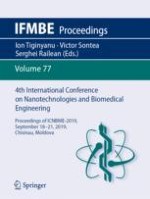2020 | OriginalPaper | Buchkapitel
Mechanical and Morphological Characterization of Decellularized Umbilical Vessels as Tissue Engineering Scaffolds
verfasst von : T. Malcova, L. Globa, A. Vascan, E. Țugui, A. Stoian, V. Nacu
Erschienen in: 4th International Conference on Nanotechnologies and Biomedical Engineering
Aktivieren Sie unsere intelligente Suche, um passende Fachinhalte oder Patente zu finden.
Wählen Sie Textabschnitte aus um mit Künstlicher Intelligenz passenden Patente zu finden. powered by
Markieren Sie Textabschnitte, um KI-gestützt weitere passende Inhalte zu finden. powered by
